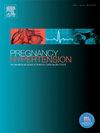Health disparities in pregnancies complicated by acute-onset severe hypertension
IF 2.9
4区 医学
Q2 OBSTETRICS & GYNECOLOGY
Pregnancy Hypertension-An International Journal of Womens Cardiovascular Health
Pub Date : 2025-05-22
DOI:10.1016/j.preghy.2025.101216
引用次数: 0
Abstract
Objective
To examine health disparities in the management and clinical outcomes of singleton pregnancies diagnosed with acute-onset severe hypertension (AOSH) during hospitalization.
Study design
Retrospective cohort study (2016–2021) of pregnant patients with AOSH, defined as systolic blood pressure (SBP) ≥ 160 mmHg or diastolic blood pressure (DBP) ≥ 110 mmHg ≥ 15 min apart.
Main outcome measures
The primary outcome was timely therapy of AOSH, defined as correctly dosed first-line antihypertensive medication administered <60 min. Secondary outcomes were adverse maternal and perinatal composite outcomes. Multivariate logistic regression models were built to assess the association between patient factors, type of OBGYN practice, institutional factors, and the primary and secondary outcomes.
Results
Of the 732 patients, 298 (40.7 %) were non-Hispanic white, 297 (40.6 %) were non-Hispanic black, and 137 (18.7 %) were Hispanic. The primary outcome was not associated with race/ethnicity or other patient factors. The odds of timely emergent therapy of AOSH were 50 % higher in the 15:00 h–22:59 h nursing shift versus other shifts (aOR = 1.48; 95 % CI: 1.02, 2.18; P = 0.04). Furthermore, patients managed by private OBGYN physicians had significantly lower odds of adverse perinatal composite outcomes than those managed by academic OBGYN physicians (aOR = 0.39, 95 % CI: 0.21, 0.73; P = 0.003). Maternal adverse outcomes were not associated with any of the study factors.
Conclusion
Timely anti-hypertensive therapy for AOSH was not influenced by maternal race/ethnicity, language, or insurance status. However, timely therapy was more likely during the evening shift, and perinatal outcomes were better with private OBGYN practice.
妊娠合并急性重度高血压的健康差异
目的探讨诊断为急性发作性重度高血压(AOSH)的单胎妊娠住院期间的管理和临床结果的健康差异。研究设计:对收缩压(SBP)≥160 mmHg或舒张压(DBP)≥110 mmHg≥15 min的AOSH孕妇进行回顾性队列研究(2016-2021)。主要结局指标:主要结局指标为及时治疗AOSH,定义为给予正确剂量的一线抗高血压药物治疗60分钟。次要结局指标为不良的孕产妇和围产期综合结局。建立多变量logistic回归模型来评估患者因素、妇产科执业类型、机构因素与主要和次要结局之间的关系。结果732例患者中,非西班牙裔白人298例(40.7%),非西班牙裔黑人297例(40.6%),西班牙裔137例(18.7%)。主要结局与种族/民族或其他患者因素无关。15:00 h - 22:59 h护理班次及时急诊治疗AOSH的几率比其他班次高50% (aOR = 1.48;95% ci: 1.02, 2.18;p = 0.04)。此外,由私立妇产科医生管理的患者出现不良围产期综合结局的几率显著低于由学术妇产科医生管理的患者(aOR = 0.39, 95% CI: 0.21, 0.73;p = 0.003)。产妇不良后果与任何研究因素无关。结论AOSH的及时降压治疗不受母亲种族/民族、语言、保险状况的影响。然而,在夜班期间更有可能及时治疗,并且私人妇产科诊所的围产期结局更好。
本文章由计算机程序翻译,如有差异,请以英文原文为准。
求助全文
约1分钟内获得全文
求助全文
来源期刊

Pregnancy Hypertension-An International Journal of Womens Cardiovascular Health
OBSTETRICS & GYNECOLOGYPERIPHERAL VASCULAR-PERIPHERAL VASCULAR DISEASE
CiteScore
4.90
自引率
0.00%
发文量
127
期刊介绍:
Pregnancy Hypertension: An International Journal of Women''s Cardiovascular Health aims to stimulate research in the field of hypertension in pregnancy, disseminate the useful results of such research, and advance education in the field.
We publish articles pertaining to human and animal blood pressure during gestation, hypertension during gestation including physiology of circulatory control, pathophysiology, methodology, therapy or any other material relevant to the relationship between elevated blood pressure and pregnancy. The subtitle reflects the wider aspects of studying hypertension in pregnancy thus we also publish articles on in utero programming, nutrition, long term effects of hypertension in pregnancy on cardiovascular health and other research that helps our understanding of the etiology or consequences of hypertension in pregnancy. Case reports are not published unless of exceptional/outstanding importance to the field.
 求助内容:
求助内容: 应助结果提醒方式:
应助结果提醒方式:


